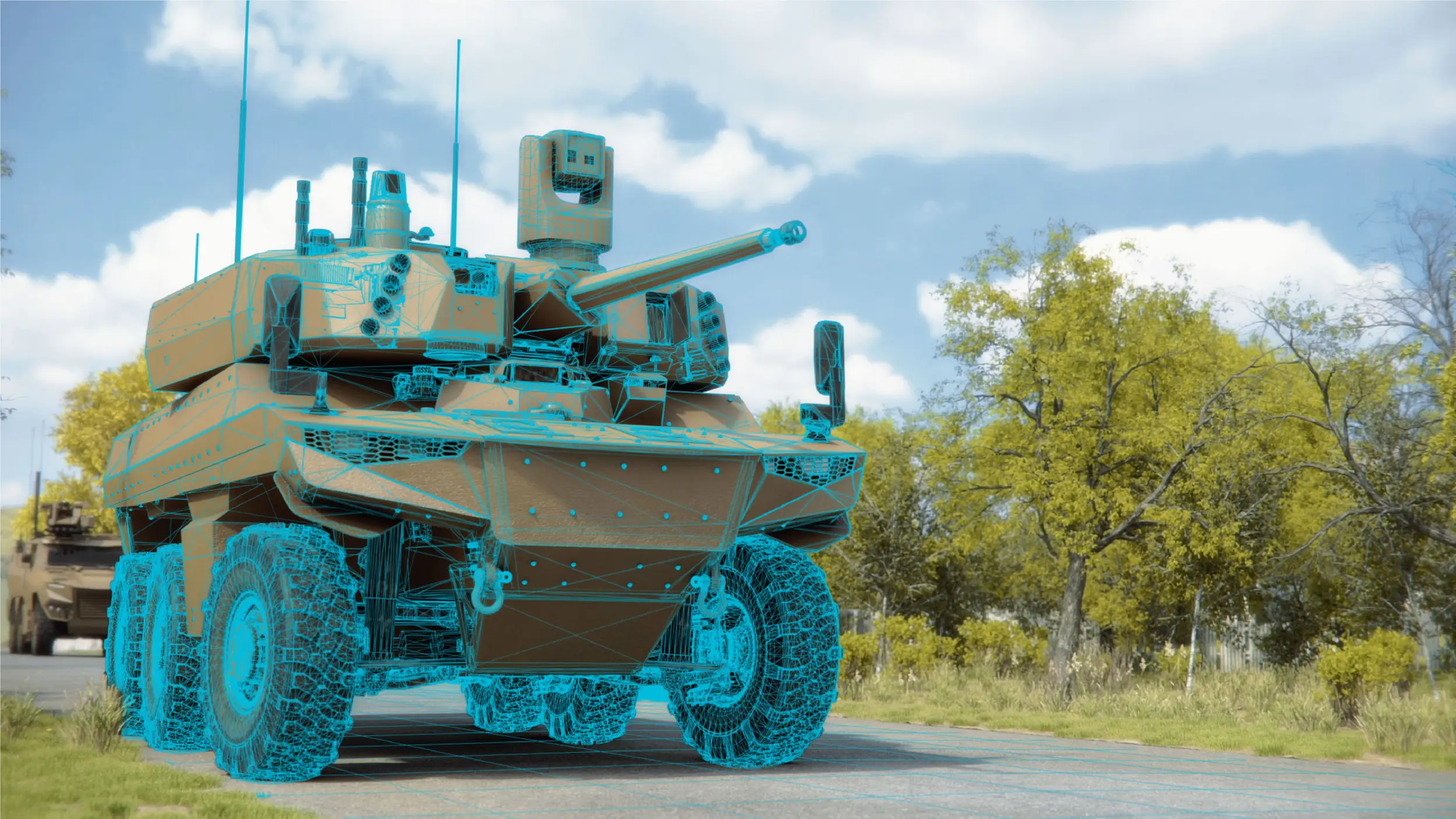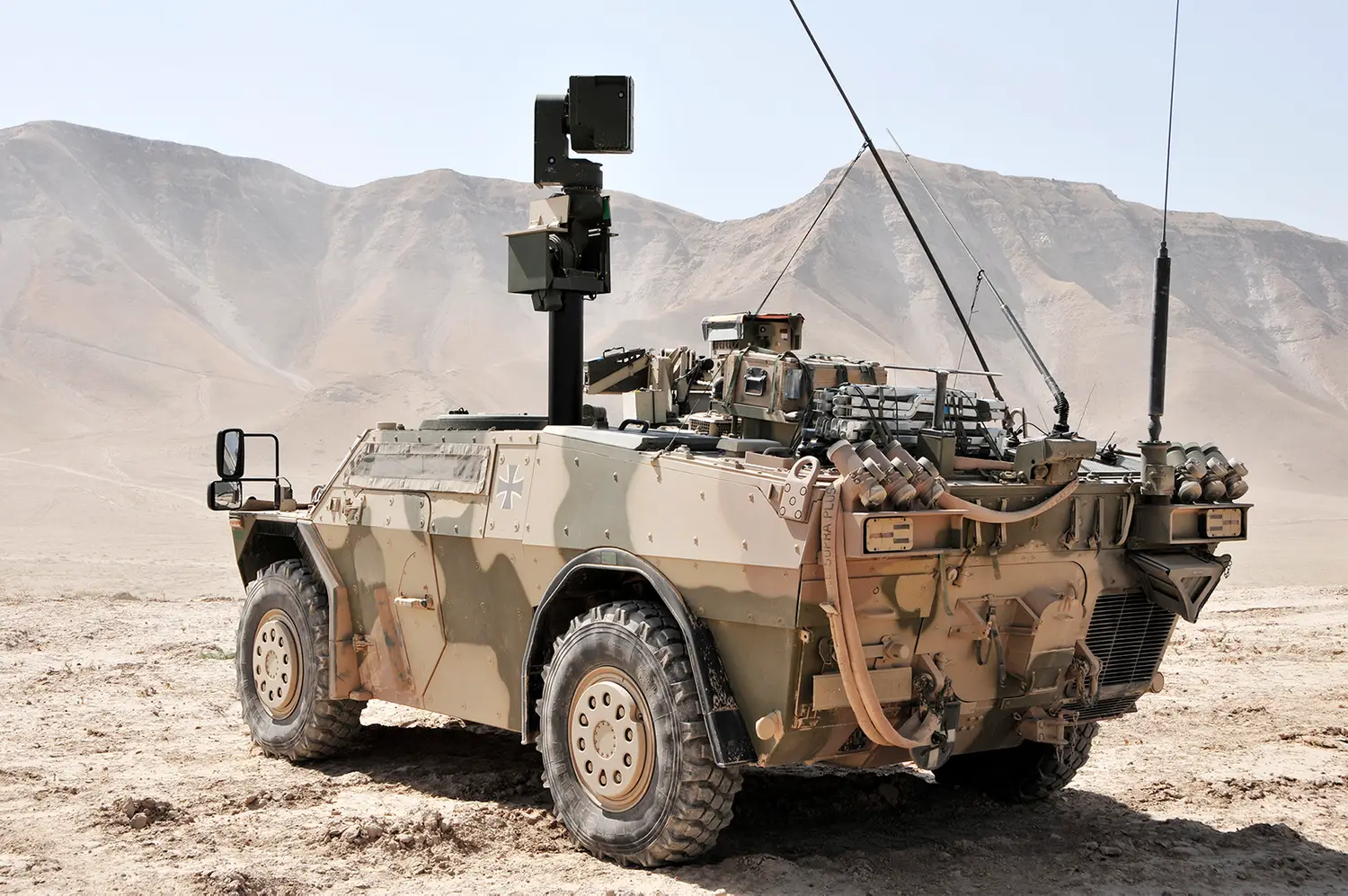
REPORT HOME > The bigger picture
Feb 2023 | technology report | NIGHT VISION & OPTICS
As the demand emphasis shifts from local situational awareness to holistically piercing the fog of war across an entire battlefield, how are the latest optical sensors helping AFV crews keep informed and stay on target?
Above: The return of large-scale armoured warfare to Europe has placed renewed emphasis on the accuracy of mobile long-range fires. (Photo: US Army)
In the age of strategic competition, the ability of mounted units to detect, identify and target near-peer or peer adversaries at stand-off ranges has become a critical requirement.
Such a capability is particularly demanded by soldiers operating main battle tanks, infantry fighting vehicles, mobile rocket, artillery and mortar systems and special operations vehicles across an increasingly complex operating environment.
Solutions can range from driver, commander and gunner ISTAR systems through to 360-degree situational awareness cameras as well as electronic warfare and counter-drone systems. Vehicle-mounted optronics also assist with mobility over arduous terrain, in addition to supporting intelligence-gathering, which in turn compresses decision-making cycles and helps ensure precision targeting of threats.
Optronic advantage
According to Thales, vehicle-mounted optronics have always been key to achieving an advantage on the battlefield, with range and accuracy as major priorities for armed forces as they seek to improve gunner's sights, laser rangefinders, and thermal imaging or infrared sensors.
'Over the last 20 years, security forces became increasingly engaged with local situational awareness. For example, there were the challenges of operating in counter-insurgency situations where proximity to civilians and careful manoeuvring outweighed the need for long-distance gunnery. However the reappearance of armoured warfare in Ukraine has meant that range and accuracy have returned as key demand signals,' a company spokesperson explained to Shephard.
Thales is confident more traditional optronics can be easily improved through the application of artificial intelligence (AI), field-upgradeable software, edge processing and autonomy.
'Today, modern vehicle optronics, augmented with AI which can reduce crew cognitive burden, allow our warfighters to positively identify and engage targets at much greater ranges or stand-off than ever over the last ten years. This contributes significantly to the survivability of our armoured vehicles and better protects our troops.
'The increase in capability that can be achieved by augmenting traditional optical sensors with AI or decision support is really exciting, especially when we are talking about sensors that are connected across the battlefield, each exporting data to a shared common picture of the battlespace,' the spokesperson continued.
'Furthermore, with software upgrades we can address an issue that has been increasing in importance over the last decade, and that is one of cognitive burden and overload for vehicle crews. With the proliferation of optics on vehicles, having a "digital crew member" who can monitor sensor feeds, and even recognise threats, is becoming a necessary must-have.'
Above: Thales believes that decision support for crews and integrated networking across a battlegroup can greatly boost the exploitation of optical sensor feeds. (Image: Thales)
But according to Thales, one of the most important demand signals emerging from vehicle-mounted units is a requirement for interoperable solutions in terms of unilateral and multi-lateral partners, particularly across NATO.
'There is a growing desire and recognition for the benefits of commonality of sensors across the land platforms of any armed force. The obvious benefit to this is a streamlined and optimised supply chain, but the emerging benefits will come when software becomes an integral part of the sensor and its use,' the spokesperson said.
Capability gaps
However, Thales warned that the market is facing a series of capability gaps as it strives to provide end-users with an optimal solution.
'There's only so far you can take vehicle optronic capability before you need to introduce digital augmentation to continue incremental improvement. The digital transformation that most militaries are going through presents the necessity of inserting data-bearing capabilities into vehicle-mounted sensors.
'The challenge however is that the market is generally split into two types of suppliers. On the one side you have the traditional OEMs who have supplied armoured vehicle sights for many years into the military, inherently having the skills and knowledge to integrate optics into the challenging world of armoured warfare.
'Whilst on the other side you have a whole host of new software designers and SMEs who may not know how to physically integrate a sight onto an armoured vehicle but can do incredible things with the sensor feed through the application of AI, self-learning algorithms, and image recognition software.
'There are some instances where the two can be brought together, particularly through the procurement of key technologies, such as digital identity, encryption, cybersecurity and cloud storage and access,' the spokesperson continued.
"There's only so far you can take vehicle optronic capability before you need to introduce digital augmentation to continue incremental improvement."
Thales also described the 'art of the possible' in terms of vehicle optronics, explaining to Shephard: 'We feel it is entirely possible to envisage a future where there is collective sensing of the battlefield, comprising a wide range of sensors, integrated onto a wide range of platforms, manned and unmanned, which all contribute autonomously to a collective understanding of the battlespace.
'These sensors, from optics to radar, acoustic to electronic sensing, can all be augmented with that application of software. This software, whether processing at the edge or at destination, can turn pixels and kilobytes into intelligence – recognising patterns, images, changes, anomalies, and linking information, corroborating evidence and providing a greater understanding from multiple sources.
'It is entirely possible to envisage a future where myriad sensors combine to create a central picture, available through a cloud, via secure communications, to communities of interest, where commanders can make informed decisions, based on the information gathered by platform-based sensors – the effective "eyes and ears" of the battlefield.'
For this to work there would need to be software and threat library upgrades available across all systems and sensors, sent remotely at regular intervals, the company said.
'Additionally, a commonality of sensors and their architecture across the whole land environment would lend itself to new procurement opportunities including software as a service or through-life management contracts such as the proposed Land Integrated Operating Service project,' the spokesperson stated.
Such a solution, Thales added, will require high levels of connectivity to ensure communications: 'Without connectivity, a future vision that includes multiple sensors contributing to a collective understanding is unachievable.'
Shared burden
In addition to sighting systems, sensors and defensive aids, Thales also offers its Digital Crew solution which comprises a self-learning platform that reduces cognitive burden across multiple simultaneous tasks. Examples include autonomous observation of optical sensor feeds.
'Digital Crew can be applied to any vehicle optronic system, either as a stand-alone support to reduce the cognitive burden on the human crew, or as a processing-at-the-edge capability that can contribute to the overall intelligence picture of the battlefield,' the spokesperson added.
Looking to the evolution of vehicle optronics over the next decade, Thales foresees a bright future for solutions capable of supporting counter-UAS missions.
This includes integration of AI into optronics, fitted on remote weapon stations to support C-UAS capabilities on board a vehicle. The company also sees more general application of software and processing upgrades to enable local situational awareness and emerging optronic developments to enhance and augment capability.
Primary source
Meanwhile, Hensoldt's head of business unit, ground-based systems, Jan Erbe, described to Shephard how vehicle-mounted optronics remain the primary data source for obtaining a comprehensive picture of a situation and creating the ability to win the fight.
'The optronics form a broad spectral band (eg infrared) and offer high-resolution images so more is seen than the human eye ever could. Especially when facing numerically superior enemies, it is hugely important to provide early and wide-ranging reconnaissance. This can be done with high-quality optronics,' Erbe explained.
According to Hensoldt, the most critical demand signals coming from mounted units include multipurpose and multi-user capabilities, which require vehicle sensors to be networked together and sensor data to be analysed in an automated way.
Above: Hensoldt views high-quality optronics as vital for creating a comprehensive situation picture. (Photo: Hensoldt)
However, Erbe warned that the market is also facing capability gaps in design and manufacture of such systems: 'Due to operational doctrine among users and training of the crews, the connection of sensors within the vehicle is still done uni-directionally between the sensor and the user. Sensor data evaluation is still carried out manually.
'Therefore, we developed a networked architecture and powerful evaluation systems which make the advantages of sensor fusion and AI-based evaluation available to the user.'
Erbe also warned of challenges associated with thermal loads, permanent data networking and physical or psychological overload of operators.
To help armed forces overcome such shortfalls, Hensoldt offers software and hardware solutions to fuse multiple sensors and process large amounts of data in real time on site. Examples include the SETAS 360-degree vision system in addition to a variety of self-protection sensors.
'Optronics will increasingly work together in networks. Different spectral ranges and "angles of view" lead to an ever faster growing picture of the situation and give the operators the time and opportunity to make better and more informed decisions,' Erbe concluded.


